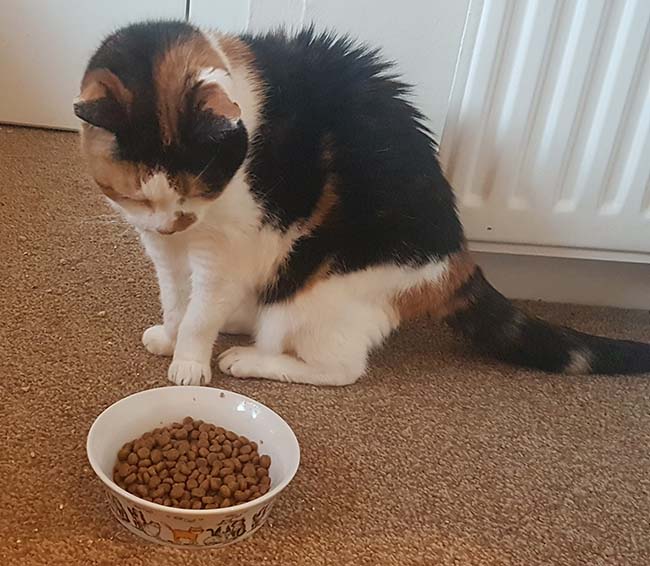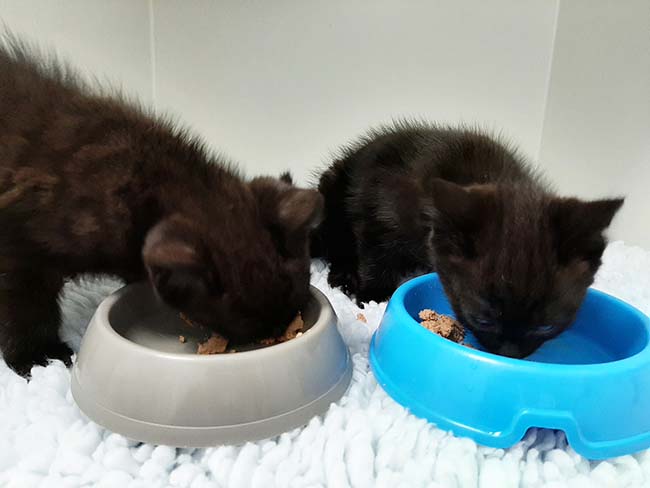14 Jan 2022
Laura Lacey looks at nutrients essential and offers advice on understanding food labels, as well as how to aid clients in picking feed appropriate to their cat or dog’s life stage.

Image: goodluz / Adobe Stock
In 2020, the pet food industry was expected to generate £2.9 billion (Wall, 2020). It is a very complex area with such a wide range of variants that it can seem daunting to many owners and, as clinical teams, we are unable to keep up to date with every new food that comes on the market.
With that in mind, we should ensure we have a good general understanding of the needs of the animals in our care, as well as being able to decipher the labels on foods that may be presented to us.
The first step to being able to support owners when it comes to choosing the right diet for their pets is by having a good base knowledge about their animal’s specific needs.
Every pet is an individual, but we can make some generalisations, such as life stage and ideal weight, to give us a solid starting point.
One of the crucial components to personalising our advice is finding out a little about the animals and their owners; their lifestyle and habits.
A client questionnaire can be given to owners or the information gathered in a consultation to help guide us. Asking a mix of open and closed questions will help you get details. Points of interest will relate to exercise, behaviour, weight and treats. The needs of an entire male, 2-year-old working collie can be far removed from a 15-year-old toy poodle.
Owners should not feel judged when they are discussing these points as we need honesty to make the best suggestions. We are here to guide future choices, not to dwell on previous ones.
Dogs are omnivores and, as such, they can adapt to very varied diets when they are in good general health, and not in times of added stress or change. The very basic nutritional needs of dogs are a good source of protein and a balance of fats. They can manage with or without carbohydrates in many instances, and can remain healthy on a vegetarian diet.
Cats are obligate carnivores and, as such, must have a meat component to their diet. This all relates to where the necessary nutrients can be extracted from.
Water is the most important macronutrient and the water content of food varies greatly. This can have an impact on how much owners perceive their animal to drink.
Dry diets are generally assumed to be around 8% to 10% water (Pet Food Manufacturers’ Association; PFMA, 2015), with some wet diets being around 84% moisture (Mars, 2021).
Dry food is, therefore, able to be more calorie dense per 100g fed. This in itself has pros and cons. Wet food can be used to increase fluid intake, particularly in cats that can be fussy.

Protein is essential to both species, and is most abundant in animal flesh.
Protein is made up of 23 amino acids and is commonly referred to as the body’s building blocks. It is required for growth and repair of the body, so the need for it varies throughout life stages. In the very young, it is required in larger quantities as they are growing rapidly. In the elderly, it is required as the ability to heal and repair is needed as the body ages.
We are often cautious with protein levels in the elderly due to the way excess protein is removed. The liver and kidneys break down and excrete the excess protein through the process of deamination and excretion of ammonia as urea. The full process is beyond the scope of this article, but it means we should look at the quality of the protein source for our ageing pets. We want high levels of bioavailability. This means they can extract the most with the least effort. Leather and chicken breast are both proteins; however, one chicken obviously will be much more beneficial.
Of the amino acids some are considered essential – 10 in the dog and 11 in the cat (Panel 1). By terming these essential, it highlights that these must be provided in the diet preformed – they cannot be synthesised by the animal. Without these amino acids, a vast number of chemical processes would fail to occur and poor health would be noted.
Not all fats are bad fats. Fat is required in the diet to provide energy. It provides 8.5kcals of metabolisable energy per gram, which is more than double the energy provided by proteins or carbohydrates. It also provides fat-soluble vitamins A, D, E and K. It is good for skin and coat health, growth and development, as well as increasing palatability, to name a few simple points.
All mammal cells are made up with a partial lipid membrane, so its requirement should not be overlooked. However, we know an excess of fat is detrimental to health as it can be laid down as adipose tissue. This puts additional pressure on some body systems, such as cardiovascular and skeletal, so we should try to guard against this.
We may need to remind owners that some fat elements are essential, such as omega-6 and omega-3. Omega-6 includes fatty acids such as linoleic acid, which is essential for both dogs and cats, and arachidonic acid, which is essential only for cats.
It is important to note omega-6 fatty acids cannot be produced by the body in sufficient quantities. They must be provided in the diet to prevent signs of deficiency. Deficiency of omega-6 fatty acids can cause skin and coat abnormalities, reproductive problems and failure to thrive.
The omega-3 essential fatty acids are alpha-linolenic acid, eicosapentaenoic acid (EPA) and docosahexaenoic acid (DHA).
EPA and DHA are found primarily in marine sources, including fish oil, as well as phytoplankton and other marine plants. Dietary requirements for EPA and DHA exist for both dogs and cats; however, requirements vary among different life stages – for example, growing puppies and kittens require more DHA than adult dogs and cats. Omega-3 fatty acid deficiency may result in neurological abnormalities, such as decreased visual acuity. (Lenox, 2021).
Carbohydrates are not considered essential in the diet. However, digestible carbohydrates provide an easy-to-use source of energy and glucose.
Indigestible carbohydrates, also known as dietary fibre, are not essential nutrients either, but they have multiple benefits, such as promotion of a healthy intestinal microbiota, adequate intestinal transit and satiation (The European Pet Food Industry, 2020).
Micronutrients are those that are found in smaller quantities in foods, with vitamins and minerals falling into this category.
Vitamins are all considered essential as they cannot be synthesised, but their daily intake requirements vary greatly. They fall into two categories: water soluble and fat soluble.
Water-soluble vitamins include the B complex vitamins and vitamin C, and, being water soluble, they are carried around in the body by water-soluble compounds. If they are not needed, they can easily be excreted via the urine. Due to this fact, it is unlikely to cause a toxicity, but it does mean a need exists for a daily provision to be taken in.
A, D, E and K are fat-soluble vitamins. Being fat soluble, they are transported by fat-soluble compounds in the body and stored in the liver. This means animals don’t need a daily intake, but it can mean we see complications associated with a build-up if the levels are not managed.
Minerals are inorganic components in pet food, often referred to as “ash” on the labels. These can also be divided into micro and macrominerals. Macrominerals are required in larger quantities and include potassium, sodium, chloride, magnesium, calcium and phosphorous. You should recognise these as the essential electrolytes that we monitor regularly, essential for homeostasis of the body.
The microminerals are iron, copper, zinc, iodine, selenium, manganese, cobalt, chromium, fluoride, molybdenum, silicon, vanadium and arsenic – often referred to as “trace elements”.
In most instances the finer details of the food compounds are balanced by the manufacturer. Toxicities and deficiencies are rare in complete, balanced diets, but they can occur so we may need to look out for signs. See Table 1 for the benefits of the nutrients.
| Table 1. Vitamins and minerals | |
|---|---|
| Micronutrient | What it does |
| Vitamin B1 – thiamin | Essential for carbohydrate metabolism. |
| Vitamin B2 – riboflavin | Essential for body cells to grow, enzyme functions. |
| Pantothenic acid | Essential for carbohydrate and fat metabolism, glucose generation, red blood cell function, hormone regulation. |
| Niacin | Needed for metabolism, enzyme functions. |
| Vitamin B6 – pyridoxine | Essential for protein metabolism, energy metabolism. |
| Biotin | Essential for protein and fat metabolism. Important for skin and hair, enzyme functions. |
| Folic acid | Essential for DNA and red blood cell maturation, mitochondrial protein synthesis. |
| Vitamin B12 – cobalamin | Essential for carbohydrate and fat metabolism. Making myelin for nerve sheaths. |
| Choline | Needed for nerve transmission. |
| Vitamin A | Vision, growth, immune function, fetal development. |
| Vitamin D | Maintenance of mineral status – particularly calcium and phosphorous balance. |
| Vitamin E | Defence against oxidative stresses. |
| Vitamin K | Activation of clotting factors. |
| Potassium | Acid-base balance, nerve impulse transmission, enzymatic reactions, transport functions. |
| Sodium | Acid-base balance, regulation of osmotic pressure, nerve impulse generation and transmission. |
| Chloride | Acid-base balance, transfer of extracellular fluids across cell membranes. |
| Magnesium | Enzyme functions, muscle and nerve-cell membrane stability, hormone secretion and function, mineral structure of bones and teeth. |
| Calcium | Formation of bones and teeth, blood coagulation, nerve impulse transmission, muscle contraction, cell signalling. |
| Phosphorous | Skeletal structure, DNA and RNA structure, energy metabolism, locomotion, acid-base balance. |
This can help to guide us if we feel an imbalance may exist. Home-prepared diets are more likely to be imbalanced if the owner has not been well advised.
It can be overwhelming trying to interpret pet food labels and many owners are not 100% sure what they are looking for in the first place. They may be influenced by human nutritional needs that they are more aware of. Many people think of protein as a “good food” and fats as bad, but it is more complex than that.
A pet food label may mention “meat and animal derivatives”, which can seem very off-putting to owners. The term meat and animal derivatives is often used to describe elements that are surplus to desire for the human food chain. This might include different types of meat, as well as materials such as the lungs, kidneys and livers, but they should still only come from animals that have been passed fit for human consumption.
The PFMA ensures all products used in its members’ foods are appropriate and safe. More than 90% of the pet food industry is registered with the PFMA and its website has a host of useful information available ready for you to offer support to owners. It helps if we understand what is in a food product so we can explain it clearly.

Also, it is essential to ensure clients understand the difference between a diet labelled as “complete” as opposed to one described as “complementary”.
If a diet is described as “complete”, it is designed to meet the nutritional needs of the animal and life stage it is described for, when fed as per a manufacturer’s instructions. If it is “complementary”, it will be lacking in some areas that need to be met elsewhere. Both wet and dry diets can be formulated to be complete and balanced, so options exist to suit all needs.
Raw diets are very popular, and also very complex; as such, we will not delve too deeply here. However, they can be formulated to be balanced with a great deal of time and effort. If a client is wishing to feed a raw diet, the author would recommend a commercially prepared one that meets high standards and is PFMA-approved.
Raw diets are not necessarily pure meat diets. Quite often, to make them affordable, as well as balanced, they do contain carbohydrates in the form of fruit and vegetables or grains.
Different nutritional requirements according to life stage exist – previously mentioned, such as protein demands being higher in the young. Different requirements also exist according to disease, such as low-fat diets in cases of pancreatitis. We cannot look at all of the specifics in this article; however, having a good knowledge of what nutrients do, we can look at how we can select the appropriate feed to suit individual requirements.
Owners often comment that they feel a dry diet is “boring”; that they wouldn’t want to eat the same biscuits every meal, every day – so they may try to offer a variety. This doesn’t always suit a dog or cat’s digestive tract. It can be slow to adapt to change, therefore sudden or frequent dietary changes can cause upsets.
You can try to explain that animals would not have options if they were gathering their own food naturally and would consistently eat what was available in their area, so if rabbit was abundant then rabbit would be the main food source.
Owners can also be influenced by advertising. If a product is promoted using a breed they own, they may feel that it is the best option for their pet.
The decision to feed wet or dry diets, or a mix, is a personal preference for the owner and the pet in most instances. Some conditions might benefit from the increased water content of wet diets, such as cats with urinary or renal concerns or greedy animals that may find the increased volume more useful.

A study performed in 2011 identified that high dietary water intake is related to a significant increase in urine volume, reduction in specific gravity and decrease in calcium oxalate relative supersaturation, demonstrating a beneficial effect of high-moisture diets on cat urinary parameters (Buckley et al, 2011). Dry diets are often more convenient for cats that like to graze or dogs that require a high-calorie intake.
When looking at the nutritional contents of a food, you will see the elements listed as “percentage dry matter”. Protein, fat, fibre and ash will all be listed. As previously mentioned, moisture should also be listed, but often in dry food it is absent, but assumed as 10%. With this information we can calculate the carbohydrate levels. Only fats, protein and carbohydrate provide energy, so if we need to calculate the kcals of a food, we can do that using the set formula as in Panel 2.
Analytical constituents
Protein: 36%
Fat: 14%
Fibre: 2%
Ash: 6%
1. First we need to calculate the amount of carbohydrate in the food above:
Carbs = 100 – protein – fat – moisture – fibre – ash
= 100% – 36% – 14% – 10% (dry diet assumed) – 2% – 6%
= 34%
2. Then we can calculate the kcals:
Protein = 3.5kcals × 36% = 126kcals
Fats = 8.5kcals × 14% = 119kcals
Carbs = 3.5kcals × 32% = 112kcals
Total = 126 + 119 + 112 = 357 kcals per 100g
Several ways exist to calculate the daily energy requirement for an animal, which is adapted according to life stage, energy expenditure, illness factors and so on. Once calculated, you can work out how much of the desired food is required to meet those needs. A balanced diet should also meet the nutritional needs within that volume.
The number of options available for owners to choose between are very varied. Many ranges are available according to budget and owners can sometimes feel like the more expensive options are better quality, which can elicit guilty feelings if they cannot afford them. That may not be the most accurate way to view this. A very expensive food may not be the right one for an individual and nurses are in an excellent position to offer advice on this, and help remove those feelings of guilt.
Knowing the pet’s needs and what the owner has in mind are the most important elements that we need to balance, and during a consultation is the perfect place for us to do just that.
Laura Lacey
Job Title